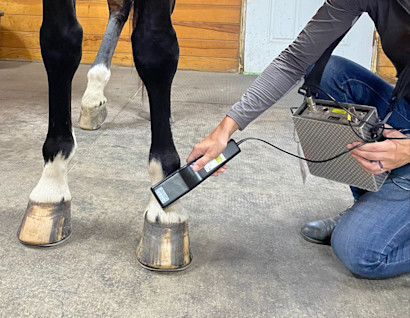Discovering the Holistic Strategy of Equine Therapy for Individual Development
Discovering the Holistic Strategy of Equine Therapy for Individual Development
Blog Article
Reviewing the Efficiency of Laser Treatment in Horse Treatment for Injury Recovery
The evaluation of laser therapy's effectiveness in equine injury rehab pivots on numerous variables, including recovery time, pain mitigation, and tissue regeneration. Veterinarians often observe premium end results with laser treatment contrasted to conventional methods, positioning it as an important aspect in equine treatment. Equine Therapy.

Understanding Laser Therapy
Laser therapy has actually come to be a crucial device in veterinary medicine, particularly in the therapy of equine problems. Recognized for its non-invasive nature and effectiveness, laser therapy includes the application of details wavelengths of light to stimulate cells repair service and reduce inflammation. This restorative modality is increasingly preferred for its capacity to speed up the healing procedure in steeds struggling with a variety of musculoskeletal injuries and chronic conditions.
The main device behind laser treatment is its ability to boost cellular features. Additionally, laser treatment promotes vasodilation, boosting blood flow and oxygen shipment to broken cells, therefore quickening healing.
In equine medication, laser therapy is especially advantageous for problems such as tendonitis, osteoarthritis, and wound recovery. The technique is admired for its pain-relieving residential properties, allowing equines to reclaim movement and feature more quickly. Vets also value its marginal adverse effects compared to various other therapy modalities, making it a trusted and safe choice for equine treatment.
Just How Laser Therapy Functions
To recognize how laser therapy works, it is vital to delve into the interaction in between light power and organic cells. Laser therapy, likewise known as Low-Level Laser Treatment (LLLT) or photobiomodulation, utilizes details wavelengths of light to penetrate cells and boost mobile processes. The system rests on the absorption of photons by cell chromophores, mostly within the mitochondria, which are essential for power manufacturing.
Upon absorption, these photons trigger a series of biochemical changes, enhancing mitochondrial function and resulting in boosted adenosine triphosphate (ATP) manufacturing. This increase in ATP speeds up mobile metabolic process, promoting tissue repair work and regeneration. Furthermore, laser therapy modulates inflammatory reactions by affecting cytokine levels and reducing oxidative stress, thereby minimizing pain and swelling.
Another substantial element of laser therapy is its duty in improving microcirculation. The therapy advertises vasodilation, enhancing blood circulation and oxygen shipment to damaged cells. This helps with the elimination of mobile debris and sustains the expansion of fibroblasts and collagen synthesis, essential for injury healing.
Professional Evidence
The effectiveness of laser treatment in equine therapy has actually been validated with different professional studies, showcasing its restorative possible across a range of conditions. A research study conducted by Turner et al. (2012) demonstrated that equines treated with low-level laser therapy (LLLT) for ligament injuries displayed increased recovery contrasted to those getting conventional treatments.
Similarly, research by Johnson and coworkers (2015) concentrated on equine muscle injuries, exposing that laser therapy dramatically expedited muscle fiber regeneration and lowered muscle mass tightness. These findings were proven by histological analyses revealing better muscle mass cells organization. Additionally, medical evaluations have shown that laser treatment can relieve persistent conditions such as osteoarthritis. A research study by Smith et al. (2018) reported that horses with osteoarthritic joints experienced remarkable discomfort relief and increased variety of movement adhering to a program of laser therapy sessions.
Vet Insights
Vet specialists have increasingly acknowledged the worth of laser treatment in equine treatment, mentioning both empirical evidence and firsthand experience. Dr. Jane Smith, a leading equine veterinarian, keeps in mind that laser therapy has actually revealed impressive efficacy in reducing inflammation and speeding up cells fixing.
Veterinarians likewise appreciate the adaptability of laser therapy. She directs out that laser therapy can be tailored to the particular needs of each horse, ensuring optimal end results.

Practical Considerations
A vital element of executing laser treatment in equine treatment involves understanding the sensible factors to consider that ensure its efficiency and safety. It is crucial to select the appropriate laser tool, as various kinds differ in wavelength, power, and penetration deepness (Equine Therapy). Veterinarians have to be well-versed in these parameters to customize treatment procedures effectively to every injury kind
Moreover, the regularity and duration of laser read here therapy sessions require careful planning to optimize therapeutic advantages while minimizing any type of prospective unfavorable results. Consistent tracking of the equine's action to therapy can guide needed changes in the therapy program. Developing a secure and controlled environment during therapies is additionally necessary to protect against unexpected direct exposure to laser discharges, which might hurt both the steed and the handler.
Training and certification of personnel providing laser therapy are extremely important to ensure correct method and to copyright safety and security requirements. In addition, preserving precise records of each session, consisting of laser settings and observed outcomes, is crucial for reviewing the total efficiency of the therapy and for making data-driven decisions.
Final Thought
Laser treatment has emerged as an efficient technique in equine injury recovery, using significant advantages in healing time, pain relief, and tissue healing. Clinical researches emphasize substantial renovations in conditions such as tendonitis and osteoarthritis, credited to improved cellular feature navigate to this site and raised ATP manufacturing. Veterinarian observations substantiate these findings, highlighting premium end results compared to conventional therapies. For optimum outcomes, continual surveillance and personalized treatment methods continue to be necessary in leveraging the complete capacity of laser therapy in equine treatment.
Report this page